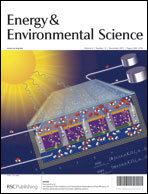N-doped monolayer graphene catalyst on silicon photocathode for hydrogen production†
Abstract
Carbon-based catalysts have been attracting attention in renewable energy technologies due to the low cost and high stability, but their insufficient activity is still a challenging issue. Here, we suggest that monolayer graphene can be used as a catalyst for solar-driven hydrogen evolution reaction on Si-photocathodes, and its catalytic activity is boosted by plasma treatment in N2-ambient. The plasma treatment induces abundant defects and the incorporation of nitrogen atoms in the graphene structure, which can act as catalytic sites on graphene. The monolayer graphene containing nitrogen impurities exhibits a remarkable increase in the exchange current density and leads to a significant anodic shift of the onset of photocurrent from the Si-photocathode. Additionally, monolayer graphene shows the passivation effect that suppresses the surface oxidation of Si, thus enabling the operation of the Si-photocathode in neutral water. This study shows that graphene itself can be applied to a photoelectrochemical system as a catalyst with high activity and chemical stability.


 Please wait while we load your content...
Please wait while we load your content...